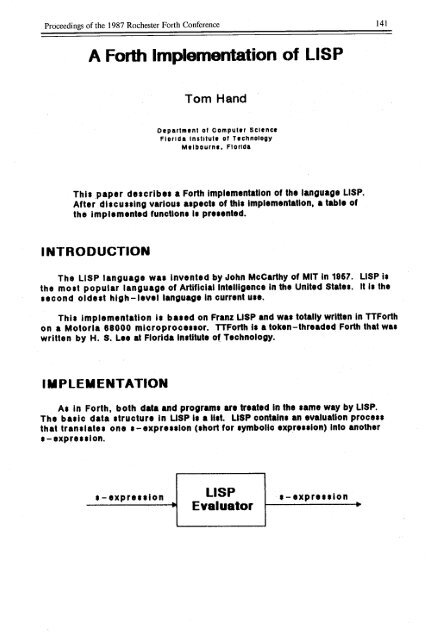A Forth Implementation of LISP
A Forth Implementation of LISP
A Forth Implementation of LISP
Create successful ePaper yourself
Turn your PDF publications into a flip-book with our unique Google optimized e-Paper software.
Proceedings <strong>of</strong> the 1987 Rochester <strong>Forth</strong> Conference<br />
A Fort Implementtion <strong>of</strong><br />
Tom Hand<br />
Department 01 computer Science<br />
Florida Institute 01 Technology<br />
Melbourne. Florida<br />
liSP<br />
Thlipaper ducrlbei a <strong>Forth</strong> <strong>Implementation</strong> <strong>of</strong> the language <strong>LISP</strong>.<br />
After dlicuiilng varloui aipecti <strong>of</strong> thli <strong>Implementation</strong>, a table <strong>of</strong><br />
the Implemented functloni II preiented.<br />
INTRODUCTION<br />
The <strong>LISP</strong> language wai Invented by John McCarthy <strong>of</strong> MIT In 1967. <strong>LISP</strong> II<br />
the moit popular language <strong>of</strong> Artificial<br />
Intellgence In the United Stat... It II the<br />
ucond oldut high -level language In current uie.<br />
Thli <strong>Implementation</strong> I1 baud on Franz <strong>LISP</strong> and wai totally written In TT<strong>Forth</strong><br />
on a Motoria 88000 mlcroproceiior. TT<strong>Forth</strong> I1 a token-threaded <strong>Forth</strong> that wai<br />
writen by H. S. Lee at Florida Initltute <strong>of</strong> Technology.<br />
IMPLEMENTATION<br />
Ai In <strong>Forth</strong>, both data and programi are treatid In thi iami way by <strong>LISP</strong>.<br />
The bailc data itructuri In USP II a liit. <strong>LISP</strong> contalni an evaluation proceii<br />
that tranilat.. oni i-expreiilon (ihort for iymbollc expre..lon) Into another<br />
i-expre..lon.<br />
1- ixpreulon<br />
<strong>LISP</strong><br />
Evaluator<br />
1- expreulon -<br />
141
142 The Journal <strong>of</strong> <strong>Forth</strong> Application and Research Volume 5 Number 1<br />
For simplicity; this implementation requires that tokens in the <strong>LISP</strong> SDurce<br />
code be encloud within blank..<br />
The primitive data objecti <strong>of</strong> <strong>LISP</strong> are called atomi; they are either number.<br />
or symbols. The basic data itructures are linked lists and propert lists. Atoms<br />
and li.t. are handled differently. Atom. have structure that i. quite .imilar to<br />
<strong>Forth</strong>; they are words but they are not directly accessible by the inner interpreter.<br />
The structure <strong>of</strong> an atom i. ilustrated by the following figure:<br />
link field<br />
name field<br />
code field<br />
type field<br />
value field<br />
propert field<br />
function definition field<br />
Type chicking is performed at run-time because <strong>LISP</strong> requires dynamic<br />
type checking. Any number <strong>of</strong> properties can be auigned to a symbol with<br />
these propertiu having arbitrary typu.<br />
Lists are repruented .. binary trees. For example, the list<br />
((a b) c (d))<br />
is represented as the following binary tree:<br />
f "r<br />
r<br />
c<br />
a b d
Proceedings <strong>of</strong> the 1987 Rochester <strong>Forth</strong> Conference<br />
It is always the case that the left node points to the current element <strong>of</strong> the list<br />
while the second node points to the remainder <strong>of</strong> the list.<br />
Standard <strong>LISP</strong> functions have been implemented 81 <strong>Forth</strong> word.. On the<br />
other hand, user defined functions are represented as binary trees In a manner<br />
similar to that done by most <strong>LISP</strong>s. Forward references are handled by maintaining<br />
a list <strong>of</strong> undefined symbols along with the addrelSes that correspond<br />
to each such symbol.<br />
A. mentioned earlier, the ba.ic operation in <strong>LISP</strong> is called evaluation. For<br />
a list to be evaluated, its flnt argument muit be a function. If such a function<br />
is detected, the remaining argument. <strong>of</strong> the Ii.t are each evaluated and finally<br />
the function itself Is evaluated.<br />
Because data structures are dynamically created and deleted, tree nodes<br />
require continual allocation and deallocatlon. Efficient memory allocation<br />
requires that garbage collection be performed to reclaim any unused nodes.<br />
A first fit algorithm decide. which memory is allocated from the free pool.<br />
Garbage collection Is performed as data structures change dynammically.<br />
INSTALLED <strong>LISP</strong> FUNCTIONS<br />
A reasonable subset <strong>of</strong> <strong>LISP</strong> functions from Franz <strong>LISP</strong> have been<br />
implemented in the current prototype. They are listed below:<br />
List Function.:<br />
car<br />
nthelem<br />
append<br />
rplaca<br />
length<br />
Comparator Functioni:<br />
and<br />
atom<br />
iymbolp<br />
equal<br />
greaterp<br />
mlnusp<br />
oddp<br />
)0 =:<br />
Data Structure Functions:<br />
setq<br />
get<br />
cdr<br />
nthcdr<br />
list<br />
rplacd<br />
reverse<br />
or<br />
null<br />
ii stp<br />
neg<br />
leup<br />
plusp<br />
=<br />
putprop<br />
plist<br />
lut<br />
con.<br />
nconc<br />
.aaoc<br />
not<br />
numberp<br />
eq<br />
nequal<br />
zerop<br />
evenp<br />
c: =<br />
defprop<br />
Evaluation Control Functions:<br />
quote eval funcal<br />
143
144 The Journal <strong>of</strong> <strong>Forth</strong> Application and Research Volume 5 Number 1<br />
+/<br />
Arithmetic Function.:<br />
mod 1+ ab.<br />
Input/Output Functions:<br />
print read<br />
msg<br />
defun def<br />
putd<br />
cond<br />
prog go<br />
n<br />
Function Definition Functions:<br />
Flow <strong>of</strong> Control Functions:<br />
CONCLUSIONS<br />
*<br />
1-<br />
load<br />
getd<br />
while<br />
return<br />
Thi. version <strong>of</strong> <strong>LISP</strong> wat tucceufully implemented a. an initial<br />
prototype. Currently, two other enhanced versions are under development<br />
that take advantage <strong>of</strong> <strong>Forth</strong>'. exten.lbilty.<br />
REFERENCES<br />
1. Brodie, L., Starting <strong>Forth</strong>, Prentlce-Hall, 1981.<br />
2. Lee, H., TTFORTH: A Token Threaded <strong>Forth</strong>, Florida In.titute <strong>of</strong><br />
Technology, 1985.<br />
3. McCarthy, J., <strong>LISP</strong> 1.5 Programmer's Manual, MIT Pre.., 1965.<br />
4. Wilenaky, R., <strong>LISP</strong>craft, W. W. Norton & Company, 1985.<br />
5. Winston & Horn, <strong>LISP</strong>, Addlson Wealey, 1984.<br />
6. Vino Q., FLlSP: A <strong>LISP</strong> Embedded in the <strong>Forth</strong> Environment, Florida<br />
In.tiute <strong>of</strong> Technology, 1986.

















